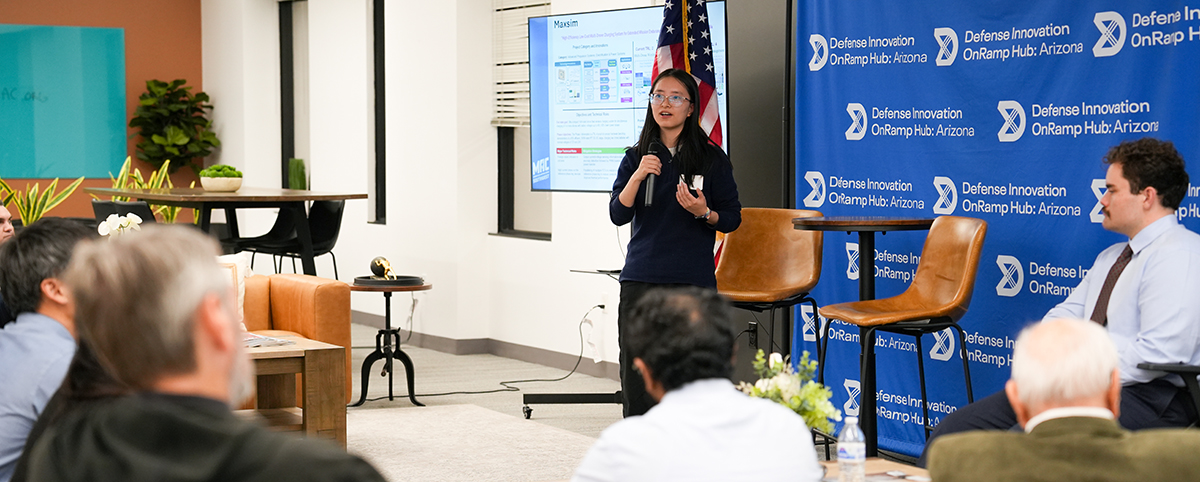
Regents’ Grants fuel innovation in dual-use technology
Arizona’s public universities and the Arizona Commerce Authority are teaming up to advance early-stage research with applications for both commercial and defense use.
The Arizona Board of Regents and the state’s public universities – Arizona State University, Northern Arizona University and the University of Arizona – are partnering with the Arizona Commerce Authority to advance technology innovations that have both commercial applications and meet national defense priorities.
The Regents’ Research Grant, approved today during ABOR’s November board meeting, will support eight projects and provide training and strategic support to reduce risk, build commercialization capacity and strengthen Arizona’s competitive position in defense-related innovation. The selection process was highly competitive, with 58 proposals submitted by faculty and researchers across Arizona’s public universities. Each proposal underwent rigorous evaluation for near-term impact, creativity, sustainability and alignment with Arizona’s priorities.
“Arizona’s universities are pioneering technologies that advance both national defense and commercial innovation,” said ABOR Chair Doug Goodyear. “By bridging research with real-world application, these projects strengthen our state’s role as a hub for dual-use technology, ultimately driving discovery that keeps our nation secure and powers new industries across Arizona.”
The ACA, the state’s economic development agency, played a key role in reviewing and scoring proposals to ensure funded projects are positioned for commercialization and broad adoption. To further amplify the impact of these projects, the board has partnered with the Arizona Office of Defense Innovation, housed within the ACA, and the Southwest Mission Acceleration Center. Together, these partners are supplying critical assets and expertise to accelerate these efforts and bolster Arizona’s role as a leader in defense-related technology development.
Examples of the projects funded include:
- Developed at ASU’s Power Electronics and Control Engineering Laboratory, the new multi-drone charging network is designed to keep drone fleets mission-ready around the clock. In defense applications, it supports continuous perimeter surveillance and reconnaissance without manual recharging. In civilian use, it enables long-duration wildfire mapping, search-and-rescue, and agricultural monitoring. By eliminating the need for one-to-one chargers and reducing system costs by more than 60 percent, the technology dramatically improves efficiency and scalability—helping drones stay airborne longer and respond faster in both national security and public safety contexts.
- Developed by NAU’s Ecosystem Science and Innovation Lab, Glasswing combines light detection and ranging (LiDAR), depth cameras, and artificial-intelligence navigation to give drones the ability to “see” and maneuver safely through dense vegetation. This under-canopy autonomy could transform how agencies monitor wildfire risk, verify carbon-credit projects, and study biodiversity—tasks once too costly or dangerous to scale. Because the same navigation challenges occur in military and disaster environments, Glasswing also positions Arizona as a leader in dual-use technologies that strengthen both ecological resilience and mission readiness.
- The U of A’s new fiber-based sensing architecture merges advanced optics with artificial intelligence to create a compact, self-powered monitoring network for both terrestrial and space applications. The same fiber that transmits data also carries laser-based power to remote sensors, reducing the need for bulky batteries or solar arrays. Applications include sensing and power delivery in remote locations and hard to access terrain such as the surface of the moor or remote locations on Earth such as volcanos, deep ocean and polar regions. Beyond planetary exploration, the technology holds promise for defense and homeland-security missions such as border monitoring, perimeter surveillance, and covert sensing in GPS-denied or electromagnetically sensitive zones—providing continuous, high-resolution situational awareness with minimal human servicing.
“Arizona’s commitment to innovation and collaboration is driving transformative research that strengthens our state’s position as a national leader in defense and technology,” said Sandra Watson, President and CEO of the Arizona Commerce Authority. “We are proud to support our universities and thank the Arizona Board of Regents and SWMAC for their partnership and dedication to advancing Arizona’s tech ecosystem.”
The full list of projects funded by the Dual-Use Technology Acceleration Regents’ Grant include:
- Distributed RF Based Positioning, Navigation, Timing and Unattributable Randing (ASU)
- High Efficiency Low-Cost Multi-Drone Charging System for Extended Mission Endurance (ASU)
- Microwave Reconfigurable Intelligent Surfaces for In-Space Wireless Power Transfer (ASU)
- A New Approach to Explainable AI (XAI): “Explanation First, Model Later” (ASU)
- Glasswing: Modular UAS Autonomy for Complex and GPS-Denied Environments(NAU)
- Cyber Resilience Against Signal Jamming for Terminal Devices in Zero-Trust, Contested Areas (NAU)
- Distributed Hybrid Fiber Sensing with Remote Power Delivery and Communications (U of A)
- Morphable Multicopter Uncrewed Aerial Systems (U of A)
Funded through the Technology and Research Initiative Fund (TRIF), Regents’ Grants bring together Arizona’s public university researchers and state government agencies to tackle pressing challenges of greatest need and interest to Arizonans. You can learn more about the Regents’ Grants program and other projects funded by the board here.
 Back to Listing
Back to Listing